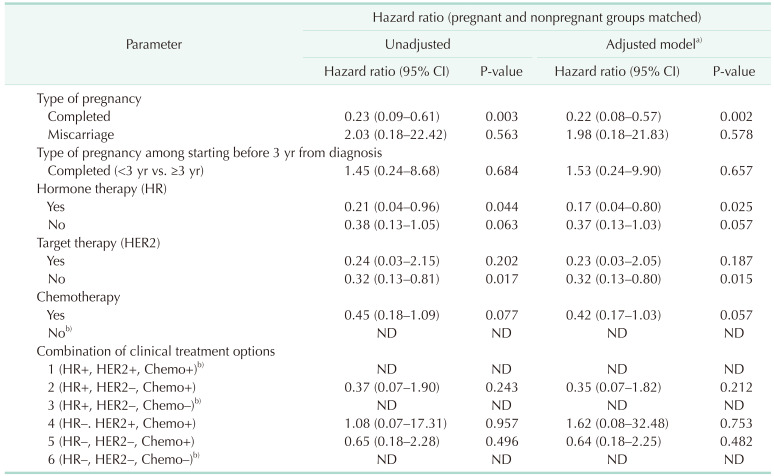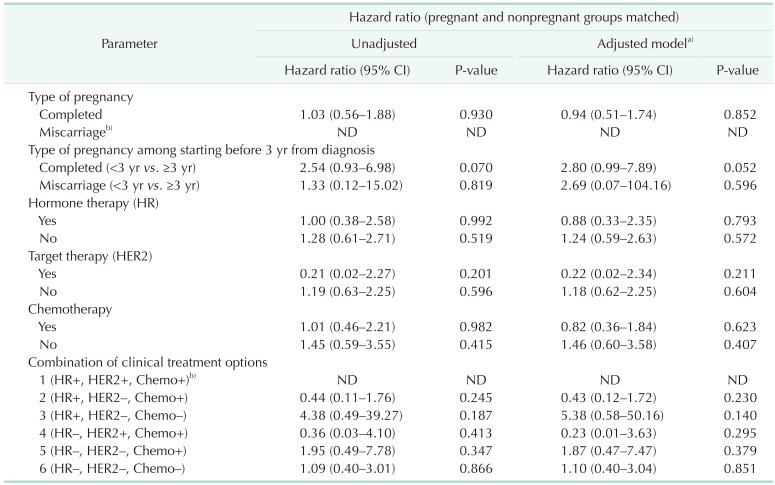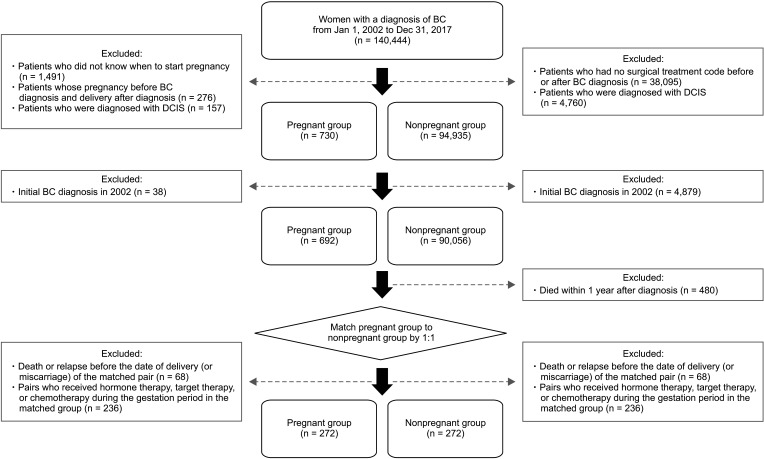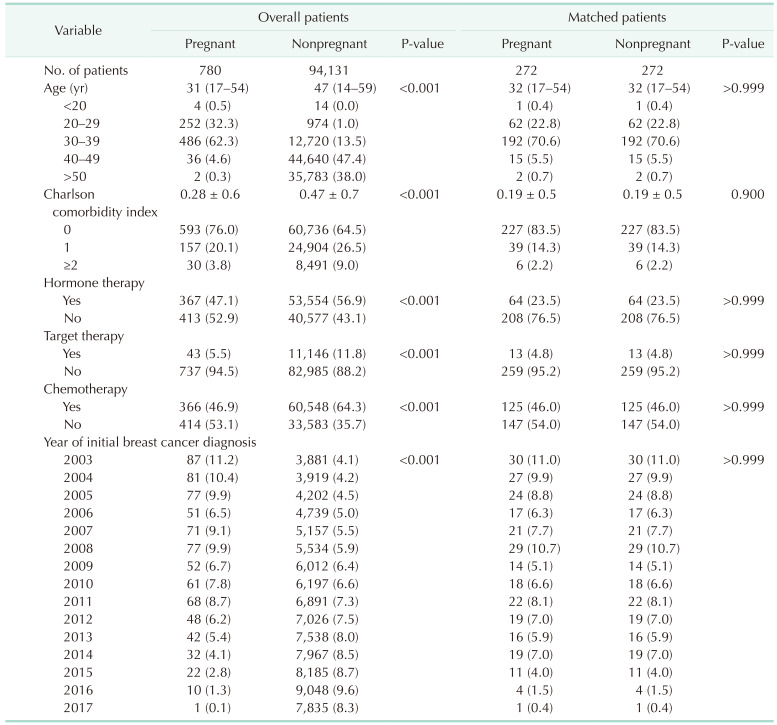1. Kim BK, Ryu JM, Oh SJ, Han J, Choi JE, Jeong J, et al. Comparison of clinicopathological characteristics and prognosis in breast cancer patients with different Breast Imaging Reporting and Data System categories. Ann Surg Treat Res. 2021; 101:131–139. PMID:
34549036.

3. Ahn SH, Son BH, Kim SW, Kim SI, Jeong J, Ko SS, et al. Poor outcome of hormone receptor-positive breast cancer at very young age is due to tamoxifen resistance: nationwide survival data in Korea: a report from the Korean Breast Cancer Society. J Clin Oncol. 2007; 25:2360–2368. PMID:
17515570.

4. Lee SK, Kim SW, Yu JH, Lee JE, Kim JY, Woo J, et al. Is the high proportion of young age at breast cancer onset a unique feature of Asian breast cancer? Breast Cancer Res Treat. 2019; 173:189–199. PMID:
30238275.

5. Kroman N, Jensen MB, Wohlfahrt J, Ejlertsen B. Danish Breast Cancer Cooperative Group. Pregnancy after treatment of breast cancer: a population-based study on behalf of Danish Breast Cancer Cooperative Group. Acta Oncol. 2008; 47:545–549. PMID:
18465320.

6. Gelber S, Coates AS, Goldhirsch A, Castiglione-Gertsch M, Marini G, Lindtner J, et al. Effect of pregnancy on overall survival after the diagnosis of early-stage breast cancer. J Clin Oncol. 2001; 19:1671–1675. PMID:
11250996.

7. Lambe M, Hsieh C, Trichopoulos D, Ekbom A, Pavia M, Adami HO. Transient increase in the risk of breast cancer after giving birth. N Engl J Med. 1994; 331:5–9. PMID:
8202106.

8. Mueller BA, Simon MS, Deapen D, Kamineni A, Malone KE, Daling JR. Childbearing and survival after breast carcinoma in young women. Cancer. 2003; 98:1131–1140. PMID:
12973836.

9. Azim HA Jr, Santoro L, Pavlidis N, Gelber S, Kroman N, Azim H, et al. Safety of pregnancy following breast cancer diagnosis: a meta-analysis of 14 studies. Eur J Cancer. 2011; 47:74–83. PMID:
20943370.

10. Azim HA Jr, Kroman N, Paesmans M, Gelber S, Rotmensz N, Ameye L, et al. Prognostic impact of pregnancy after breast cancer according to estrogen receptor status: a multicenter retrospective study. J Clin Oncol. 2013; 31:73–79. PMID:
23169515.

11. Ives A, Saunders C, Bulsara M, Semmens J. Pregnancy after breast cancer: population based study. BMJ. 2007; 334:194. PMID:
17158581.

12. Kranick JA, Schaefer C, Rowell S, Desai M, Petrek JA, Hiatt RA, et al. Is pregnancy after breast cancer safe? Breast J. 2010; 16:404–411. PMID:
20522097.

13. Lambertini M, Kroman N, Ameye L, Cordoba O, Pinto A, Benedetti G, et al. Long-term safety of pregnancy following breast cancer according to estrogen receptor status. J Natl Cancer Inst. 2018; 110:426–429. PMID:
29087485.

14. Russo J, Moral R, Balogh GA, Mailo D, Russo IH. The protective role of pregnancy in breast cancer. Breast Cancer Res. 2005; 7:131–142. PMID:
15987443.

15. Peccatori F, Cinieri S, Orlando L, Bellettini G. Subsequent pregnancy after breast cancer. Recent Results Cancer Res. 2008; 178:57–67. PMID:
18080443.

16. Ives AD, Saunders CM, Semmens JB. The Western Australian gestational breast cancer project: a population-based study of the incidence, management and outcomes. Breast. 2005; 14:276–282. PMID:
16085234.

17. Charlson ME, Pompei P, Ales KL, MacKenzie CR. A new method of classifying prognostic comorbidity in longitudinal studies: development and validation. J Chronic Dis. 1987; 40:373–383. PMID:
3558716.

18. Chow S, Wang H, Shao J. Sample size calculations in clinical research. 2nd ed. Boca Raton, FL: Chapman and Hall/CRC;2008.
19. Pagani O, Ruggeri M, Manunta S, Saunders C, Peccatori F, Cardoso F, et al. Pregnancy after breast cancer: are young patients willing to participate in clinical studies? Breast. 2015; 24:201–207. PMID:
25662412.

20. Pagani O, Price KN, Gelber RD, Castiglione-Gertsch M, Holmberg SB, Lindtner J, et al. Patterns of recurrence of early breast cancer according to estrogen receptor status: a therapeutic target for a quarter of a century. Breast Cancer Res Treat. 2009; 117:319–324. PMID:
19137426.

21. Azim HA Jr, Peccatori FA, de Azambuja E, Piccart MJ. Motherhood after breast cancer: searching for la dolce vita. Expert Rev Anticancer Ther. 2011; 11:287–298. PMID:
21342046.

22. Colleoni M, Rotmensz N, Robertson C, Orlando L, Viale G, Renne G, et al. Very young women (<35 years) with operable breast cancer: features of disease at presentation. Ann Oncol. 2002; 13:273–279.

23. Lambertini M, Martel S, Campbell C, Guillaume S, Hilbers FS, Schuehly U, et al. Pregnancies during and after trastuzumab and/or lapatinib in patients with human epidermal growth factor receptor 2-positive early breast cancer: analysis from the NeoALTTO (BIG 1-06) and ALTTO (BIG 2-06) trials. Cancer. 2019; 125:307–316. PMID:
30335191.

24. Li Y, Zhang Y, Wang S, Lu S, Song Y, Liu H. The effect of subsequent pregnancy on prognosis in young breast cancer patients (≤35 years old) according to hormone receptor status. Cancer Manag Res. 2021; 13:1505–1515. PMID:
33623430.

25. Berry DL, Theriault RL, Holmes FA, Parisi VM, Booser DJ, Singletary SE, et al. Management of breast cancer during pregnancy using a standardized protocol. J Clin Oncol. 1999; 17:855–861. PMID:
10071276.

26. Sankila R, Heinävaara S, Hakulinen T. Survival of breast cancer patients after subsequent term pregnancy: “healthy mother effect”. Am J Obstet Gynecol. 1994; 170:818–823. PMID:
8141209.

27. Nye L, Rademaker A, Gradishar WJ. Breast cancer outcomes after diagnosis of hormone-positive breast cancer and subsequent pregnancy in the tamoxifen era. Clin Breast Cancer. 2017; 17:e185–e189. PMID:
28185739.










 PDF
PDF Citation
Citation Print
Print





 XML Download
XML Download